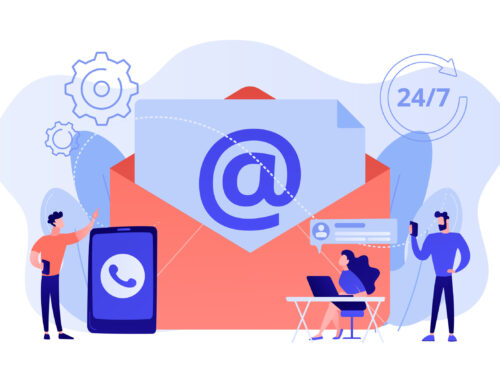Before you call anybody or send any single mail, you should start planning your lead generation campaign by preparing the basics. From my experience the key areas are:
The ideal customer profile gives you detailed information about who your customer is. In B2B, it’s important to understand that you usually have a few buyer personas that can have a strong impact on the purchasing decision.
Preparing the market value proposition and understanding pain points is essential to selling a product. Startups often focus on what they do and how great functionalities their product has while they miss and forget to tell customers what would be the main business value for them and why they should pay for it.
The sales process gives you and your customer a roadmap of how many stops you will have before signing a deal. Every stage of the sales process should be described and understood by you and your customers. To better understand it, you should realize that the customer at every stage has different questions. A well-prepared sales process should give you know-how about where you and your customers are in it. It might happen that on a different market, this process would be slightly different.
Before we start working with any companies, we usually run 2 meetings to discuss these key areas. When we collect all the knowledge from the workshops, we are able to start the process of lead generation.
Ideal Customer Profile (ICP)
The ideal customer profile should answer a question: to whom do you want to reach your messages, and who is in your target? You will probably have a few different profiles of ideal customers. When we speak about the Ideal Customer Profile, we should talk about companies and roles that you want to reach. You have to talk differently to people who are responsible for finance, engineering, or daily operations at your customer company. Every person will have a different understanding of the added value.
Many companies make the same mistake: they target the C-levels. Usually, it’s a bad strategy as everybody is targeting them. From my perspective, it’s important to talk with the people who report to the decision-maker and can discuss with him the proposition and lead to the meeting with them and you. Creating the right ICP is fundamental to the whole lead generation activities and to the success of your Polish market entrance.
As a basic, it’s important to discuss the targeted companies and people who work in the companies. You should specify size, profile, industry, core business of the companies, responsibilities of the people with whom you want to speak. Later on, you should list potential roles and positions of these people and segment them.
Based on my experience, I usually segment roles into 3 stakeholders group: Decision maker, user, and manager. Every group will have a different problem and would have a different impact on the sales process. After you prepare your segments, you should prepare the arguments for each of them. Of course, with an engineer or with the Head of IT, you wouldn’t talk about the financial impact. Same with the end-user, you wouldn’t talk about ROI. It’s important to differentiate the messages and arguments.
We always run 2 workshops with our customers before we start any lead generation activities to prepare the ICP and to have their detailed description.
Market Value Proposition
All the people and companies that fit the Ideal Customer Profile description need to understand what would be the added value for them. For example, the CEO needs to know why he should spend money on your solution and what he will have from it. As a lead generation agency, we need to have this information from you. The same with other profiles that are identified as Ideal Customer Profiles. To all of them, we should prepare a different market value proposition that will answer the most common question in sales:
“Why should I buy your solution and what will I get from it?” The same is with business partners; it will sound like “Why should I work with you and what will I get from it?”
Every strong point of the presentation should highlight the main problem of your customer and prepare the answer for it. If you do not have it, I swear to God there is no chance that any customer will buy anything from you. Unless he finds how you can help him. This leads us to the definition of a niche. When your customer can position you in a niche that you are able to fulfill, then it’s great. As an example, just think about this in this way: When was the last time you wanted to buy shoes?
Really, you thought about shoes? Or rather you would think about budget shoes for running, or some shoes that you can wear on a casual situation, that will match properly with your most common wearing clothes? The customer has to think exactly the same with his problem. To prepare a market value proposition, you should answer yourself the following questions:
- What is the problem that my product/service solves?
- What is the solution to that problem?
- What would be the effect of the solution?
During our workshop before the lead generating activities, we go together with you through these questions.
Pain Points
With a market value proposition, you should strongly analyze the pain points and the impact of this pain point. In the ideal world, you should be able to recalculate them into money or time. Daniel Kahneman discovered that almost two times higher motivation is losing something than getting the profit from something. Your customer should understand what he loses if he doesn’t buy your services or product.
You should list your pain points very carefully. For me, for example, the most common pain points of my customers are:
- They don’t speak Polish.
- They don’t understand the Polish business culture.
- They are unable to prepare the Polish demo environment.
- At the beginning, they have a very high cost per single lead if they attempt to do lead generation campaign on their own in the Polish market.
- They don’t have enough human resources to take care of the process of market entrance.
The cost of market entrance and market validation with own sales force is expensive.
You can think about pain points like a hammer. Nobody wakes up and thinks, “I need a hammer!” But many people think, “I need to nail this picture to the wall…”
This leads us to the main important question: how to find pain points? You can ask your customers why they bought your product, you can ask your customer why he came to the presentation and what are their pain points and what he is looking for currently, and why is he looking for?
Of course, this area we also cover together with you before we start any lead generation activity.
Sales Process
The biggest guru marketing Philip Kotler described the 7P of marketing mix. Without going too much into this subject, I would just tell you that one of the very important parts of it is a process. I deeply believe that without a sales process, it’s impossible to multiply sales.
There are many definitions of the sales process and how it should look like. I deeply believe that the sales process should be the mirror of the purchasing process.
Basic purchasing process
- Identification of the problem
- Education
- Searching for the solution
- Validation of the solution
- Purchasing
Every step of this process requires different actions from your side. Of course, every step has different obstacles.
Of course, there will be many different subprocesses in the sales process. For example, onboarding or pre-onboarding.
Depending on what service you choose, we can help you validate and adjust your sales process to the Polish market. We do it in the workshops and every week during the weekly review call.
Communication to the Customers
To achieve a good result with lead generation, we need to understand your communication with the customers. It’s important for Sales Development Representatives to understand how your customers are talking, what you communicate, and how you communicate. What encourages them for the meeting. Sales Development Representatives need to read and learn the branch slang and environment in which you are working.
Based on this and previous information, we prepare the storytelling. When you pitch a customer on a new market, you are a blank card for them. They do not know anything about you, and you have a maximum of 15-30 seconds to convince them to talk with you and to listen to you. In emails, usually, you have 2 sentences to convince them to read your whole copy (titles just sell it that they open your email). That’s the reason why good storytelling is so important.
To better understand it, try to think about your customer as a busy man who had 4 meetings today and he is before the 2 next one, he has to pick up his kids from a school at 3 PM, he is tired, unsleepy, and he has too many tasks to do that he is able to do. When you have the context of the situation of this man, and you understand his daily routine, you are able to prepare the communication. Usually, less is more, so every message, every call should be short and maximum concrete.
This man doesn’t have time for making big analysis and benchmarking. He will unconsciously try to find some similarity to his situation, that leads you to the situation when you have to use storytelling.
The pitch should include all the elements that we discussed before. You should tell him the business story that would sound a little bit like this: the hero is somebody with whom he can identify, and your solution is like Excalibur that this guy can use to defeat a bad dragon, that leads him to a situation where he will marry the princess and have lands from her father.
Of course, we will prepare communication together with you during the onboarding process. There is actually more about it because depending on our cooperation we should think about communication on the different stages of the sales process and to the different ICPs. For example:
- Before the presentation.
- During the demo.
- After the demo.
- In customer support.
Communication should also build trust, and for building trust, we can create a big separate article. But always remember about the context in which you are and your customers. This will help you better navigate your dialog together with him.
Summary
If you’ve come to this point, you might see that there is a lot of work to do before you start lead generation. Maybe you have already prepared everything; then great, we will have less work to do, but if not, do not worry, we always go through all of these areas with every customer.
All these elements are a big part of the market entrance and lead generation. We are here to prepare them together with you. After preparing all of the areas, we can start generating leads for you!

I am dedicated to facilitating your entry into the Polish market. At Architecture of Sales, my team and I are committed to enhancing your visibility and boosting sales in Poland through the following strategies:
- Market Validation Activities - We conduct comprehensive market research, analysis, SWOT assessments, competitor evaluations, and direct customer interviews to validate your market approach.
- Lead Generation - Utilizing both outbound and inbound methods, including various Sales Development Representative (SDR) prospecting techniques, we generate high-quality leads to drive your sales pipeline.
- Sales and Marketing Support - Acting as your local sales and marketing department, we adeptly represent your brand to customers, providing comprehensive support to strengthen your market position.
- Business Partner Identification - Whether identifying a local partner or developing an effective affiliate program, we assist in establishing valuable collaborations to optimize your market presence.
While our primary focus is on B2B SaaS companies, we are also open to collaborating with hardware-selling enterprises. For instance, we have successfully sold SaaS solutions, including ERP systems, to diverse sectors such as manufacturing, construction, retail, IT, HR, and EHS management.





